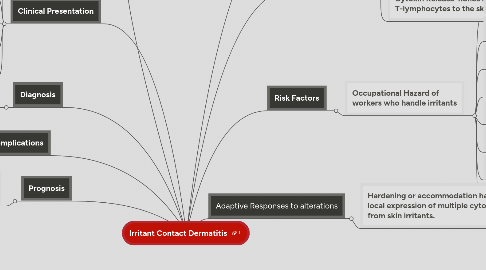Irritant Contact Dermatitis
by Taleah Anderson


1. Etiology
1.1. Common cutaneous irritants
1.1.1. Solvents
1.1.2. Mechanical Irritants
2. Clinical Presentation
2.1. Redness
2.2. Cracking of skin
2.3. Dryness
2.4. inflamed
2.5. thickened
3. Diagnosis
3.1. Patch Test
4. Complications
4.1. Infection
5. Prognosis
5.1. Good if there are no secondary complications
6. Epidemiology
6.1. Occupational Hazard
6.2. Prevalence
6.3. Environmental factors
6.3.1. Skin susceptibility (eg. thick, thin, oily, dry, very fair, previously damaged skin or pre-existing atopic tendency)
7. Pathophysiology
7.1. Skin Barrier Disruption
7.2. Epidural Cellular Changes
7.3. Cytokin Release hones naïve T-lymphocytes to the skin
8. Risk Factors
8.1. Occupational Hazard of workers who handle irritants
8.1.1. Textile workers
8.1.2. Nurses
8.1.3. Printers
8.1.4. Agricultural workers
8.1.5. Mechanics
8.1.6. Artists
8.1.7. Cleaners
8.1.8. Construction workers
